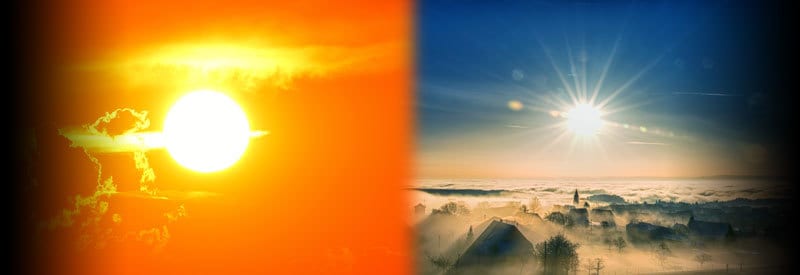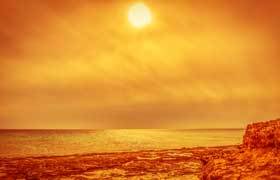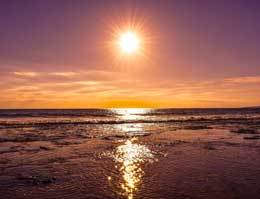The Warmest And Coldest Time Of The Day – When They Occur And Why

A common misconception exists among readers that the warmest time of the day occurs during midday, while the warmest occurs at midnight. However, both events take place much later than one may expect.
The warmest time of the day primarily occurs within three to five hours after noon, after the Sun is at its highest point in the sky, and the coldest time occurs within an hour after sunrise, while the Sun's radiation is still too weak to exceed the Earth's rate of cold emission into the atmosphere.
It only makes sense to reason that the warmest time of the day occurs at midday, while the Earth receives the most solar radiation, and the coldest time occurs at midnight when the sun is on the opposite side of the planet. But actually, both events occur much later.
This does not seem to make sense since the Earth receives the most amount of solar radiation from the sun around noon (depending on your location and the time of year.)
Similarly, the surface will keep on cooling down during the night until sunrise, when it starts to receive sunlight and begins warming up. It is natural to reason, therefore, that the coldest time of the day will be just before sunrise. But this is not the case.
This article examines when the warmest and coldest part of the day is and why they occur at these different times. It also looks at the various factors involved in these occurrences.
Warmest Time Of The Day
As already mentioned, the Earth's surface receives the most amount of solar radiation around noon, yet this is not the part of the day that is the warmest.
Before we look into why this occurs, it is important first to define a clear definition of when precisely the warmest part of the day is:
What Is The Warmest Time Of The Day?

The warmest time of the day occurs between 3 pm and 4:30 pm, 3-5 hours after noon (when the sun is at its highest point in the sky). This delay is due to the Earth's surface receiving and absorbing heat at a higher rate than it can radiate until mid to late afternoon, when the process reverses.
Although this summary is an accurate average to use to judge when a day will be at its warmest, a couple of factors can cause the actual peak temperature to occur earlier or later in the afternoon.
Weather elements such as cloud cover and wind can have a significant impact on peak daily temperatures. Geographical location also has an effect, where inland regions can reach their highest temperatures of the day much later in the afternoon than coastal areas.
Why The Warmest Time Of The Day Occurs In The Afternoon
Although the sun is at its highest point in the sky and the Earth receives the most amount of solar radiation around noon, we now know that the day's highest temperature does not occur until around 3 pm. This delay is also known as Thermal Response.

Thermal response occurs as follows: After noon, even though the sun's radiation starts to drop, the Earth retains much of its heat while still receiving solar radiation. It means the heat building at the surface is higher than that which the planet can radiate away.
As a result, the temperature continues to rise until the solar radiation is weak enough for the Earth's ability to radiate heat back into the atmosphere, becomes greater than the radiation it receives. And this occurs between 3 pm and 4:30.
Coldest Time of the Day
Like the warmest time of the day, the coldest time of the day occurs much later than one might expect. What makes it even more confusing is the fact that weather forecasters often refer to daily lows that will be experienced "during the evening."
It is statements like these that back up the common belief that the coolest time of day should occur during the night. As much as this type of thinking seems to make sense, it is not accurate at all.
As is the case with the warmest time, it is important to define when precisely the coldest time of day is first before we delve into explaining why and how this takes place:
The Coldest Time of the Day

The coldest time of the day occurs approximately an hour or more after sunrise. It occurs when the sun's radiation is still too weak to warm the planet's surface at a higher pace than the Earth's rate of emitting heat away from the surface into the atmosphere.
This may not seem to make sense at first since solar radiation is the primary source of heat and light to the Earth every day.
Take into consideration, though, that when we perceive the sun to rise on the horizon, it is still 6 degrees below the horizon (aka twilight). The atmosphere can bend light like a lens, making it appear that we receive sunlight when very little solar radiation is present.
Depending on your location and time of the year, after sunrise, it will also still take the sun between 3 and 8 hours to reach its highest point in the sky, and the Earth to receive maximum solar radiation after sunset.
Although these are all contributing factors, the main reason for the coldest time of the day involves the same factors responsible for the warmest part of the day, which we will address in the next section.
Why The Coldest Time Of Day Occurs After Sunrise
After the warmest time of the day, which occurs around 3 pm, the Earth continues to radiate heat out into the atmosphere at an accelerated pace. At the same time, solar radiation decreases until it completely disappears around sunset.
The planet's surface continues to cool down as it radiates heat throughout the night. After sunrise, the ground starts to receive solar radiation, but it is still too weak to counteract the rate at which the surface continues to cool down as it radiates heat into the atmosphere.

The coldest time of the day occurs once the speed at which the Earth radiates heat is no longer greater than the incoming solar radiation, and the ground starts to warm up. As already stated, this occurs some time after sunrise.
The exact time the coldest stage of the day takes place depends on atmospheric conditions, as well as the location and the time of the year.
Conclusion
Although it may not have made sense in the beginning, it should now be clear why the warmest and coldest times of the day occur when they do. It also explained why the delay between the period of maximum solar radiation and the warmest time of the day takes place.
This delay occurs on a seasonal basis as well. The warmest and coldest days of the year (and the warmest and coldest months) are based on the same principle. To find out more about these occurrences, you can find the in-depth article here.
This article aimed to examine when the warmest and coldest part of the day is and why they occur at these times. It also looked at the various factors involved in these occurrences.
Never miss out again when another interesting and helpful article is released and stay updated, while also receiving helpful tips & information by simply clicking on this link .
Until next time, keep your eye on the weather!
